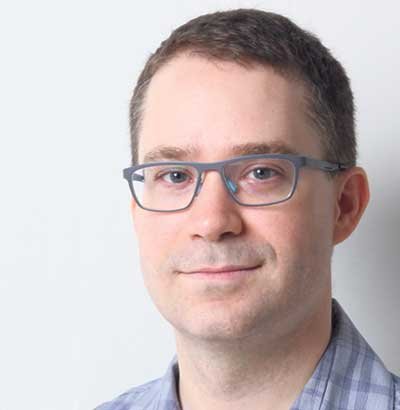Nuclear medicine leading the way in the emergence of new era in cancer treatment: individualized, precise and targeted
Dr. Sten Myrehaug (centre) and other members of the Sunnybrook team who work across disciplines to support cancer patients. Sunnybrook Health Sciences Centre
Cancer is complex, varied, and no two cancer patients are alike. Researchers and clinicians have learned a lot over the past two decades about how different types of cancers develop, how they respond to treatment and the impact it has on individual patients.
This expanded knowledge has led to the emergence of cutting-edge solutions that are the very definition of “individualized, precise and targeted,” – today’s gold standard for cancer treatment.
“In the past, treatments usually involved a ‘one size fits all’ approach, killing cancer cells but also healthy cells in the process,” says Dr. Sten Myrehaug, a radiation oncologist in the Odette Cancer Centre at Sunnybrook Health Sciences Centre in Toronto.
“Over time, better imaging and expanded knowledge about the disease processes and molecular drivers of various cancers have brought us to a new era of personalized medicine, which includes directly attacking the cancer cells with targeted therapy,” he says.
“With RLT, we take the radio-labelled molecules used to highlight tumour cells in positron emission tomography (PET) imaging and harness them to deliver therapy to those cancer cells. Targeting the cancer cells and sparing healthy tissues increases the likelihood that we can control the cancer in a way that’s less toxic for patients. ”
One of the newest targeted therapies has arisen from the field of nuclear medicine, which is usually associated with cancer diagnostics rather than treatment.
Advances in nuclear imaging have given medical practitioners the ability to see and identify detailed features of cancer cells. The latest way of treating cancer, radioligand therapy (RLT), is based on this approach.
“With RLT, we take the radio-labelled molecules used to highlight tumour cells in positron emission tomography (PET) imaging and harness them to deliver therapy to those cancer cells,” says Dr. Myrehaug. “Targeting the cancer cells and sparing healthy tissues increases the likelihood that we can control the cancer in a way that’s less toxic for patients.”
This blending of diagnostic technologies with therapeutic applications is known as “theranostics,” a new treatment category that is revolutionizing treatment for certain cancers that have traditionally been difficult to identify and treat.
Advances in theranostics are also elevating the importance of building multidisciplinary teams that deliver personalized cancer treatments.
“Nuclear medicine specialists are playing a key role in this new paradigm of theranostics and individualized treatment planning,” he says. “Team members from nuclear medicine, medical oncology, radiation oncology, surgical oncology, radiology, endocrinology, pathology and more, each contribute to customization for the patient – from their initial assessment through treatment identification, delivery of the therapy and monitoring their journey post-treatment.”
More traditional ways of treating cancer such as surgery, chemotherapy and external radiation remain standard treatment options for many patients. The RLT era has had its beginnings in the treatment of neuroendocrine cancers, and this targeted approach is being explored further for certain forms of prostate and other cancers.
Researchers continue to investigate the potential of RLT, he says. “We are gathering data to better understand the best patients for this therapeutic approach and the best timing in the patient journey for its delivery, while building the capacity to deliver the therapy in centres across the country, bringing care closer to home for patients.
“I’m confident that we’ll be expanding the reach of targeted radioligand therapies. While this approach may not be appropriate for all types of cancer, I see RLT holding much promise for the future.”
To view this report on The Globe's website, visit globeandmail.com
To view the full report as it appeared in The Globe's print edition: World NET Cancer Day


